

Ben Zachariah
Move over, Patrol: New-era Ford Maverick SUV imagined
14 Hours Ago
Two of the very best non-luxury small hatchbacks square off. The updated Hyundai i30 N Line Premium warm hatch meets the slinky Mazda 3 G25 Astina.

Senior Contributor
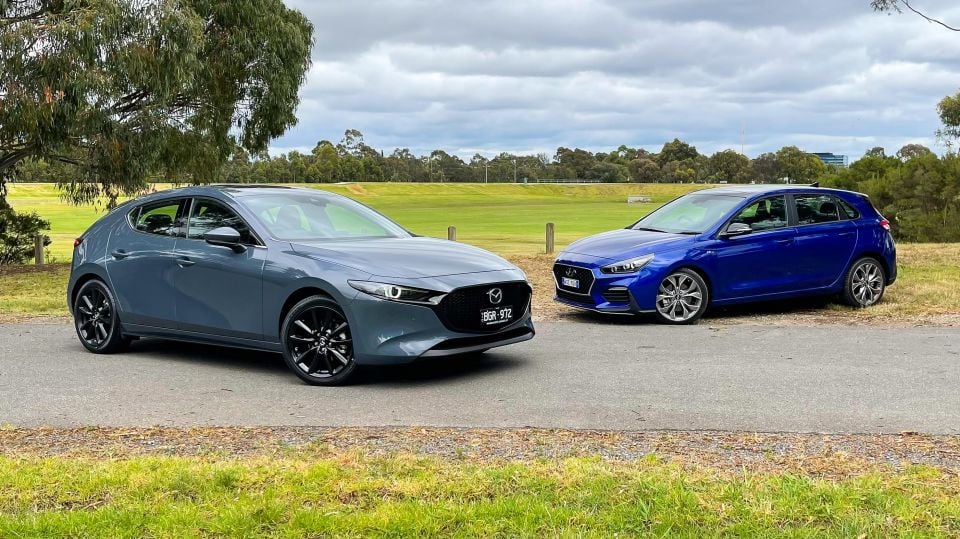

Senior Contributor
The Hyundai i30 and Mazda 3 are two of the most enduringly popular hatchbacks on sale, alongside key rivals like the Toyota Corolla, Kia Cerato, Volkswagen Golf, Ford Focus, and Honda Civic.
The rationale for this comparison lies in the recent launch of Hyundai’s updated i30 range, which brings design changes at the bottom end of the range, and introduces more modern and sophisticated cabin technology to higher grades like the one tested here.
So why not put it up against an equivalent Mazda 3 derivative?
We’ve chosen two expensive, richly specified grades here, both with a performance bent.
Target demographics? You might be be someone who avoids SUVs as a point of pride, or you may be keen on a premium Euro hatch but can’t justify spending that sort of coin.
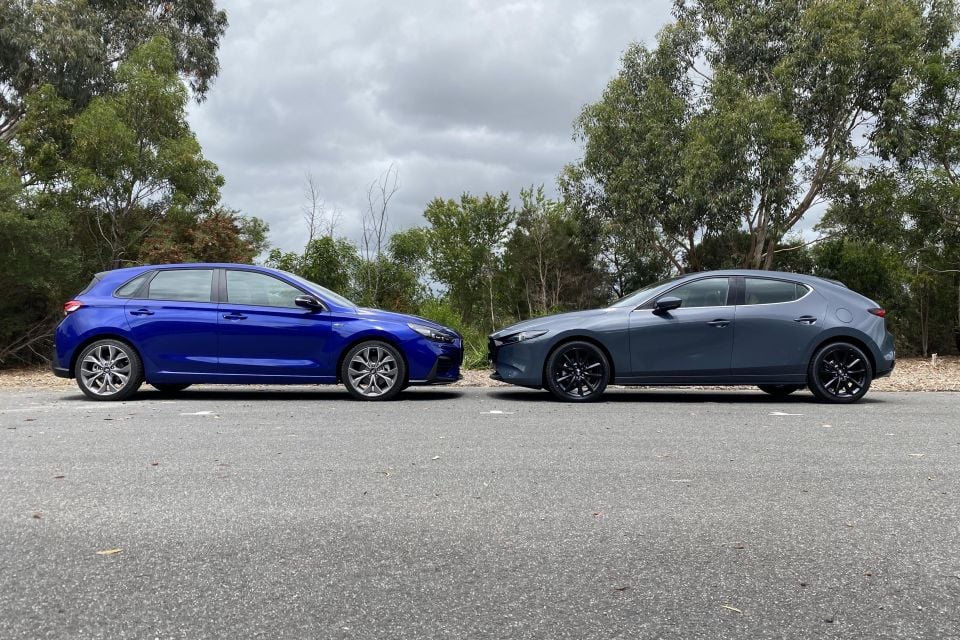
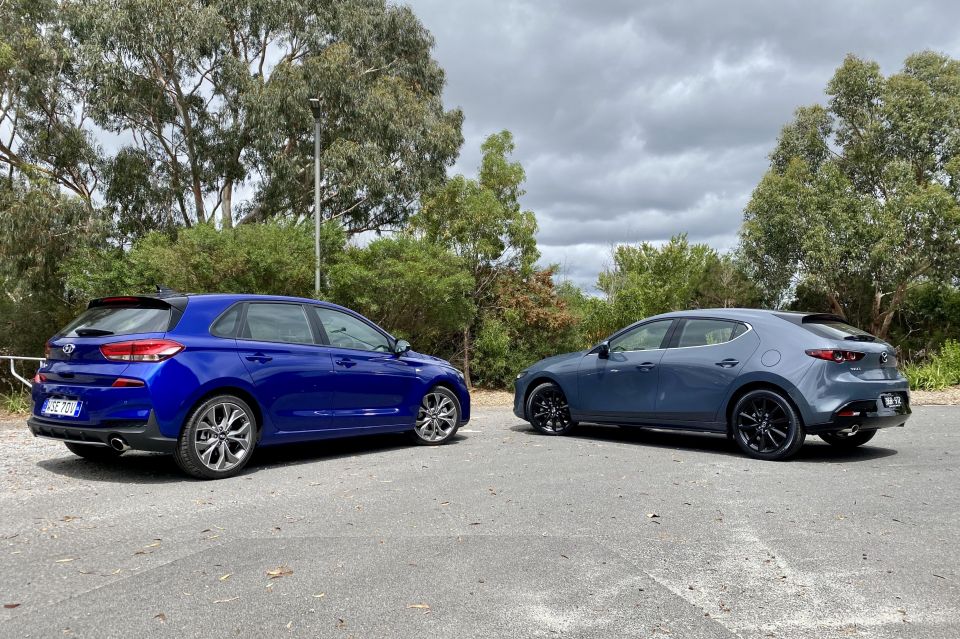
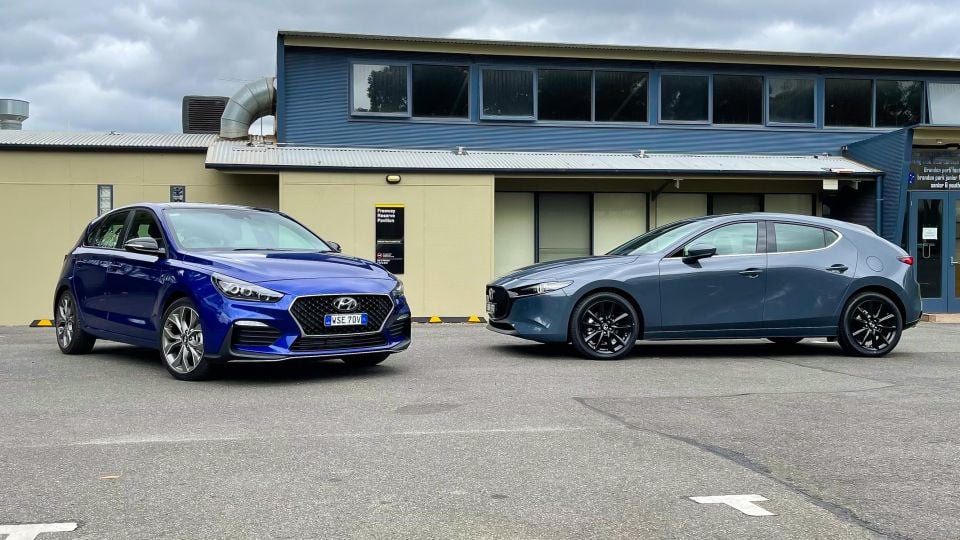
Leaving aside the Nurburgring-honed N hot hatch, the N Line Premium is the ritziest of all i30 models.
It wears a list price of $36,220 before on-road costs, which equates to a rough drive-away price (State-dependent) of $40,400.
This puts it neatly between the Mazda 3 G25 GT variant ($35,090 before on-road costs) and the G25 Astina ($38,590).
We have chosen the latter here due to fleet availability. Its estimated drive-away price sits at a neat $43,000.
Beyond those rivals mentioned in the introduction, which all come in flagship forms positioned there or thereabouts with this pair, there are entry-grade European luxury products for the aspirational set, which offer fewer features but a more primo badge.
They include the base Audi A3 30 TFSI at at $36,600 before on-road costs, the BMW 118i at $46,990, and Mercedes-Benz A180 at $45,100.
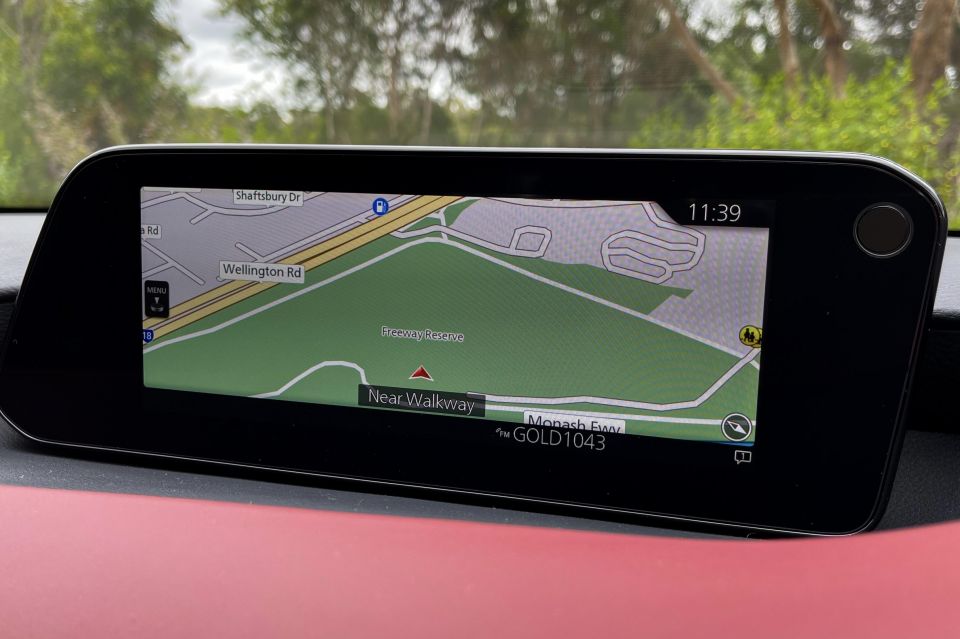
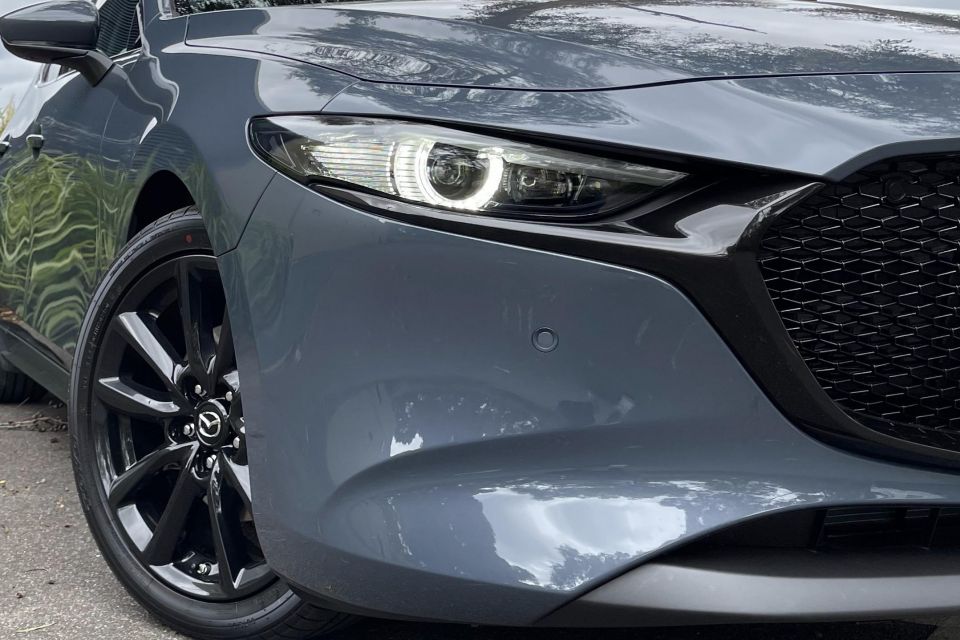
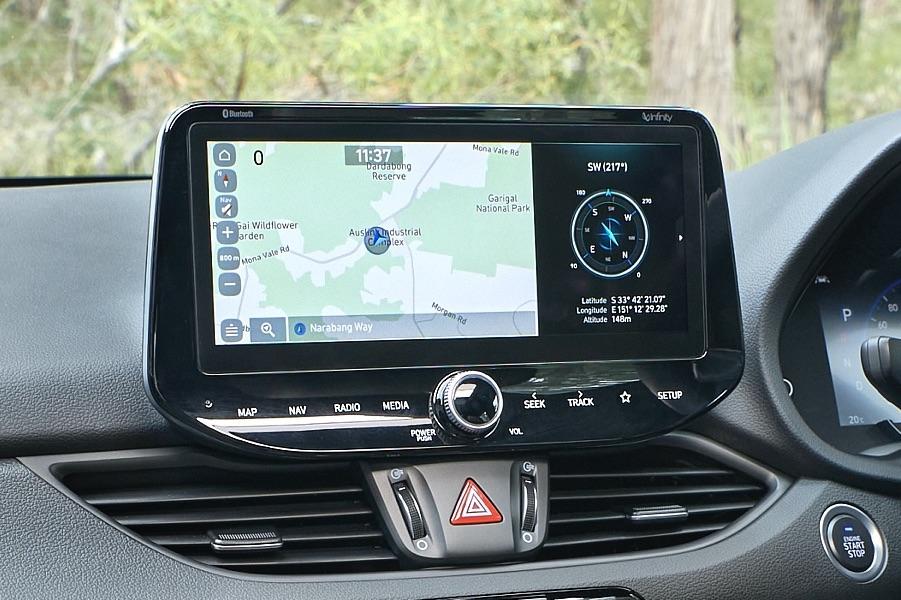
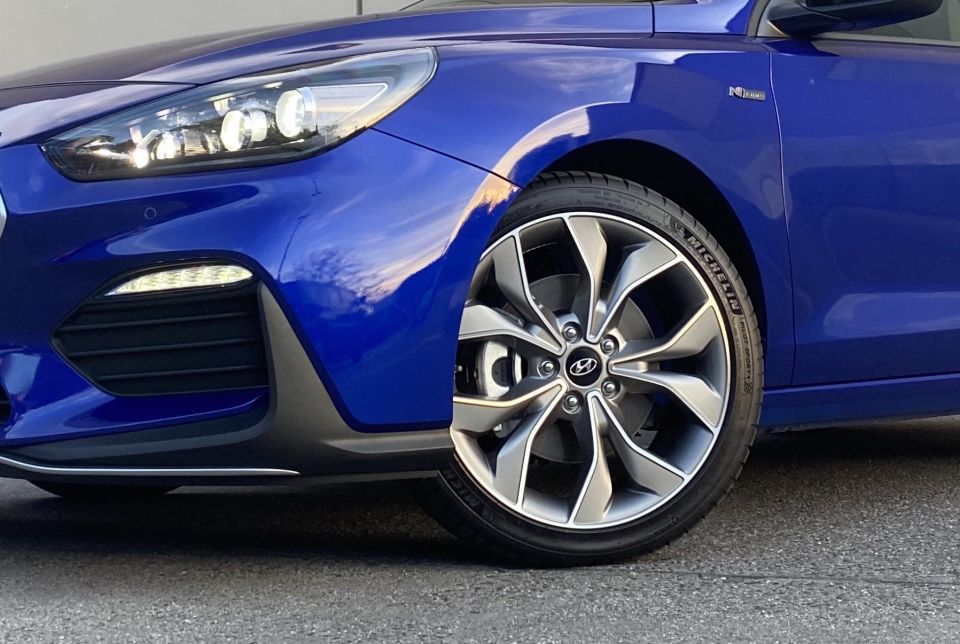
Given these are pitched as luxurious, range-leading variations, it’s little surprise they’re both generously specified.
Both come standard with 18-inch alloy wheels and a temporary spare, LED headlights and tail lights, proximity key access, and auto-folding side mirrors.
Inside you get leather seats with heating for front occupants, two-zone climate control with rear-seat vents, satellite-navigation, digital radio, wired Apple CarPlay and Android Auto, and auto-dimming rear-view mirrors.
The Hyundai alone offers front seat ventilation/cooling, a Qi wireless phone charger, and its sunroof is a panoramic unit that spans the whole roof length. It also has a larger infotainment screen – 10.25 inches versus 8.8 inches.
The Mazda counters with unique features such as driver’s seat memory presets, a heated steering wheel, a 360-degree parking camera view, a head-up display (HUD), and side mirrors that dip to show the kerb when you’re in reverse.
Its 12-speaker Bose audio system trumps the Hyundai’s seven-speaker Infinity system on paper, too.
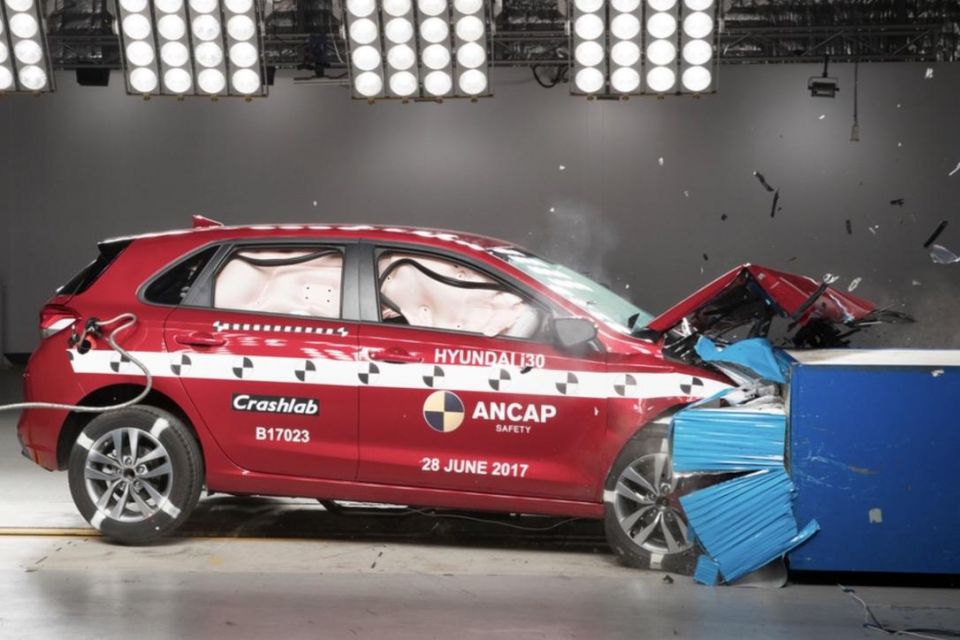
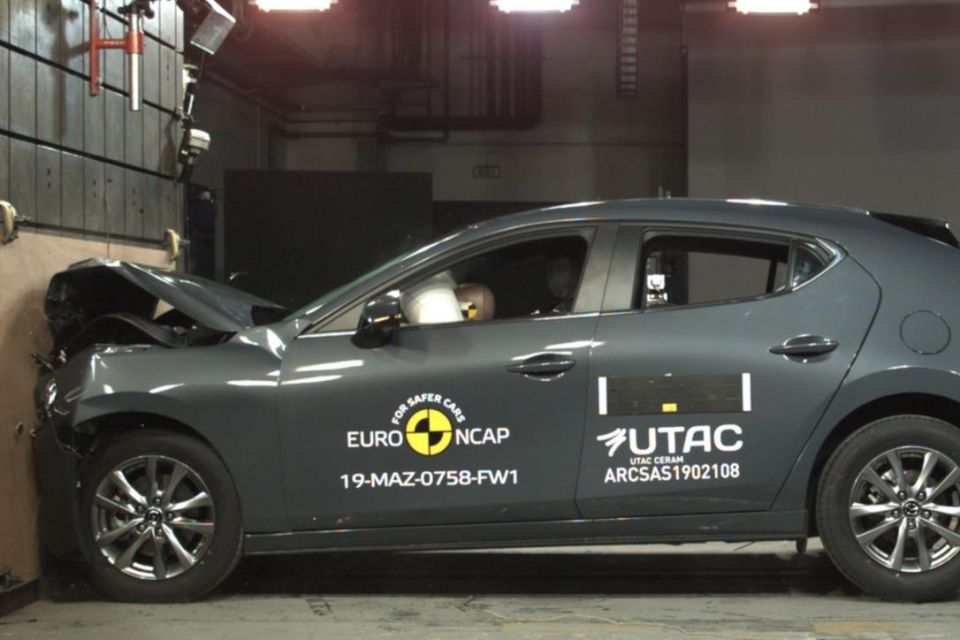
Reassuringly so.
Both come with seven airbags, ISOFIX and top tethers for child seats in the back, and active tech including low- and high-speed forward autonomous emergency braking (AEB) with pedestrian and cyclist assist.
Each also has active (steering control) lane assist, active or adaptive cruise control, and driver-alertness monitors.
The Mazda takes things a step further by including blind-spot monitoring signals in the side mirrors, AEB that functions in reverse, and both front- and rear cross-traffic alerts (the former projects arrows into the HUD unit).
It’s worth noting that the cheaper, but less powerful, i30 Elite grade ($30,220 list) does come with rear cross-traffic alert and blind-spot monitoring, as well as Safe Exit Assist that alerts occupants if they’re set to open their door into the path of a parallel moving car or cyclist.
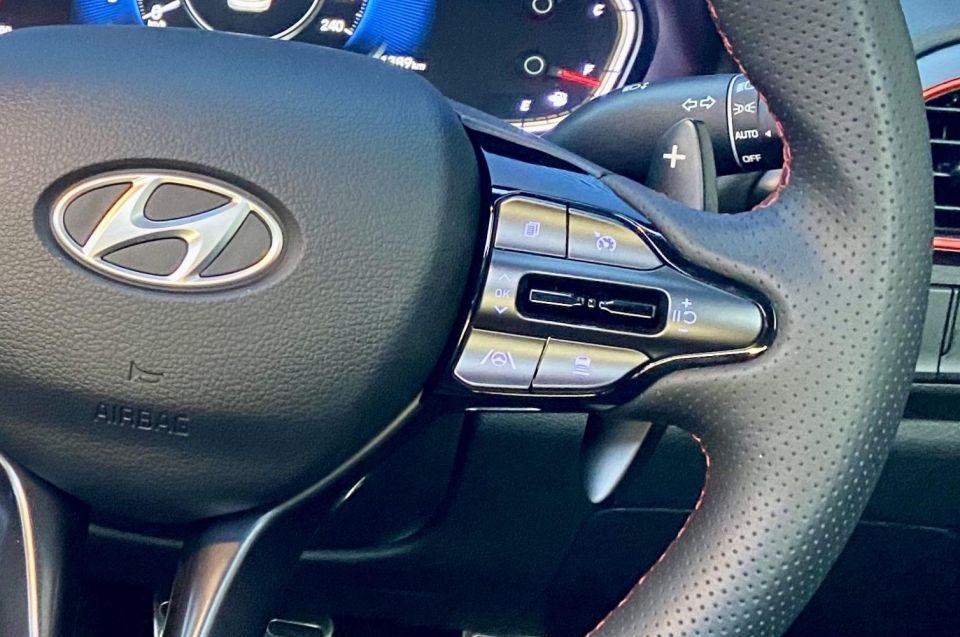
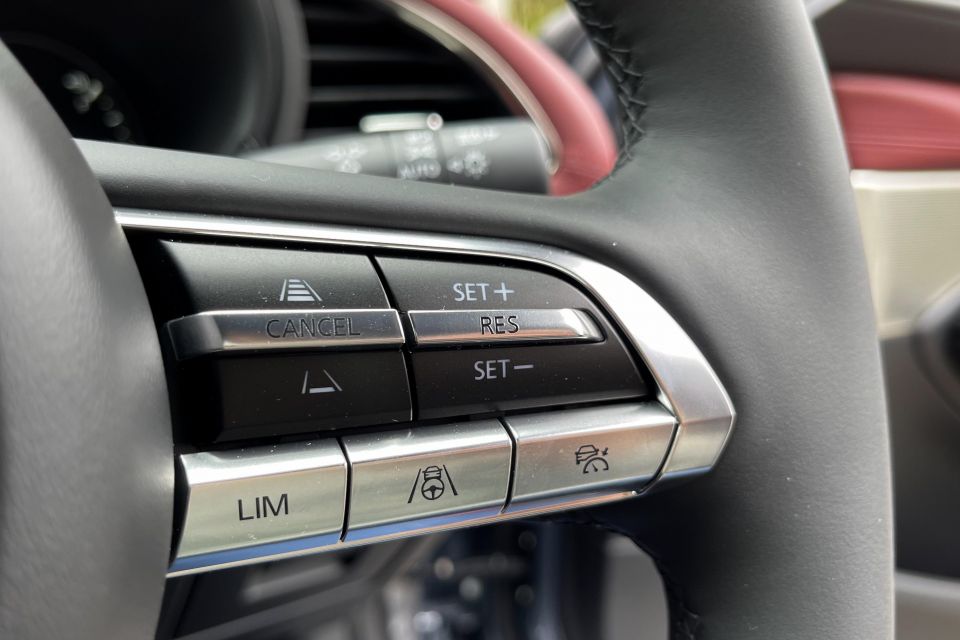
It’s disappointing that tech available on a mid-spec variant is not offered in the flagship.
To its credit, Hyundai’s active steering assist with lane centring is more proactive and better at keeping the car away from road lines. The Mazda’s system sort of panics when you nudge the white line and jerks the car back into where it needs to be. Calibrations needed.
Nevertheless, the Mazda justifies the extra impost it commands when it comes to luxury and safety features.
Regardless of which vehicle you opt for, you get a five-star ANCAP-certified crash rating.
The Hyundai has a 2017 date stamp and a score of 35 out of 37.
The Mazda was tested against newer 2019 measures, and scored a phenomenal 98 per cent for adult occupant protection, 89 per cent for child occupant protection, 81 per cent for vulnerable road user protection, and 76 per cent for its active safety features.
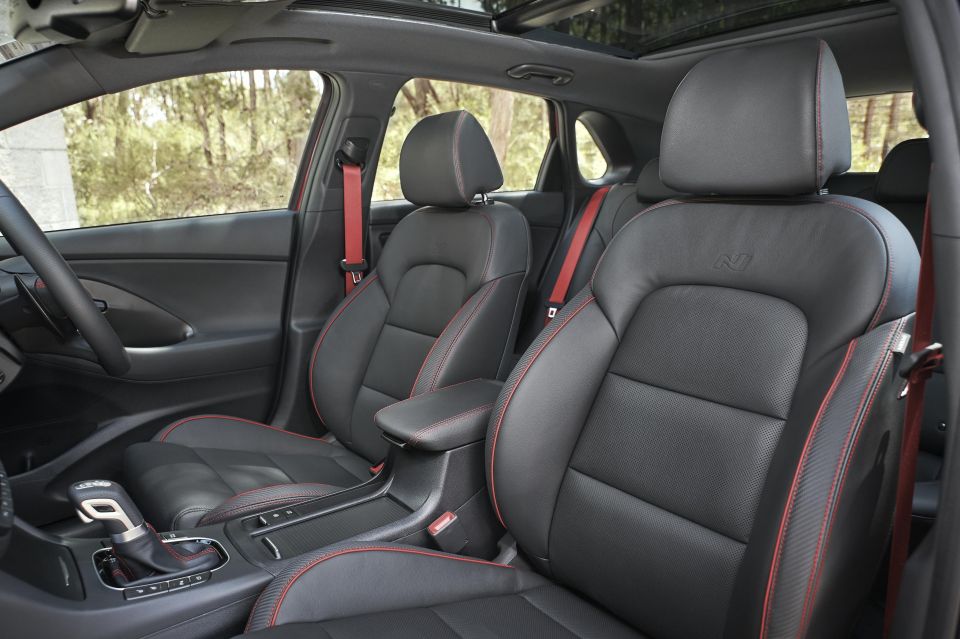
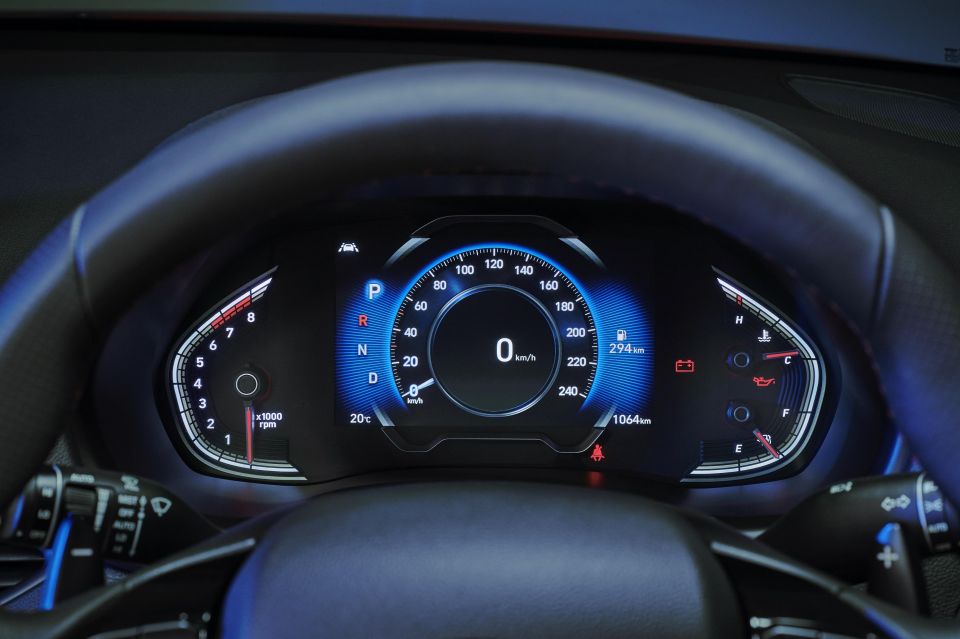

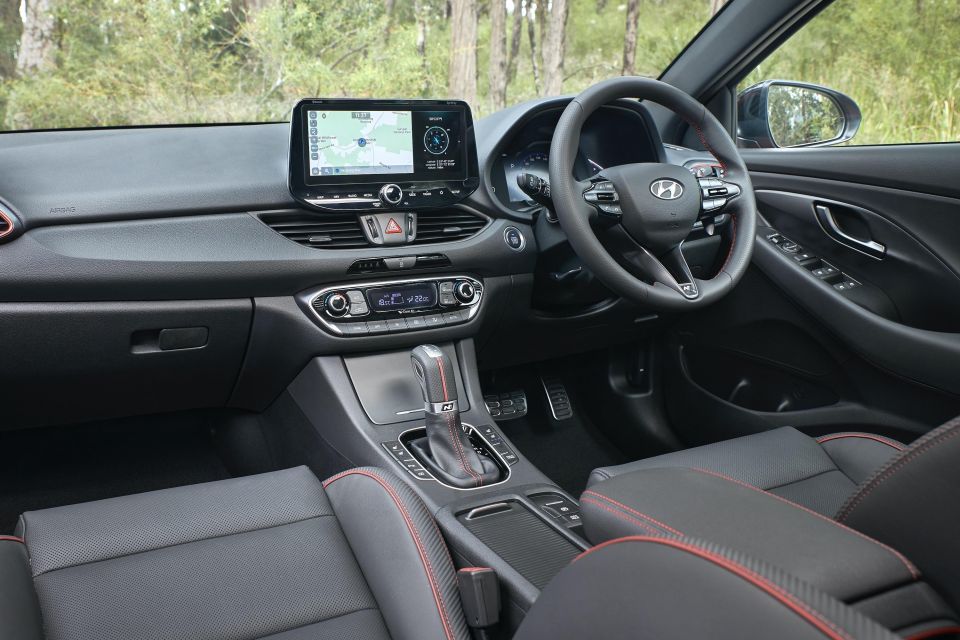
Hyundai:
The new bits in here are the bigger centre touchscreen and slicker driver’s instruments.
The interior material quality and tactility still feel a rung beneath those used in the Mazda, however the build quality is good and there are numerous storage cubbies. It’s more utilitarian with a hint of pizzazz, than outright luxury.
The use of red plastic on the vent surrounds, as well as the stitching and piping on the sporty and grippy leather seats, and seat belts, liven things up. Ditto the metallic pedal caps.
There’s plenty of seat adjustment (fore/aft/up/down/lumbar) and a nice steering wheel, though the paddle shifters aren’t all that nice to look at or touch. Having ventilated seats in summer is a genuine delight.
The new TFT instrument display changes colour based on your driving mode, and I appreciated the retention of an analogue tachometer. It’s hardly brimming with sub menus, but I personally welcome the simplicity.
The new touchscreen looks a little tacked on, and I don’t love the overuse of shiny black plastic trims, but the presence of touch-capacitive shortcuts and a physical volume dial aid usability, and it’s a commendably simple operating system with good functionality.
In terms of pure screen real estate, it leaves its competitors for dead.
You can view beautiful maps and audio concurrently in split screen, the camera resolution is crisp, and there are some nifty functions including a program that plays soothing sounds of nature through the speakers. That Infinity audio system is decent.
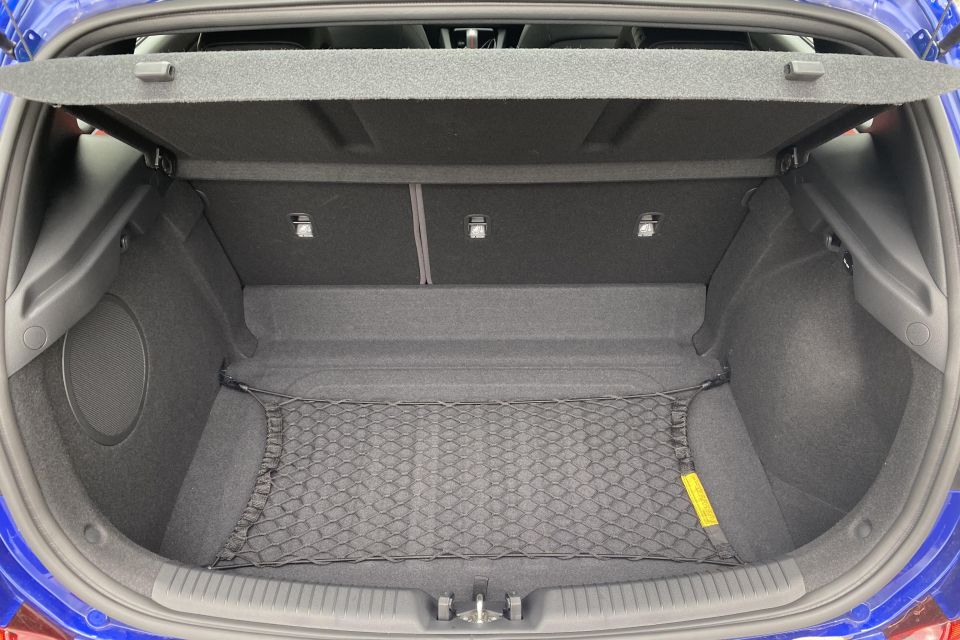
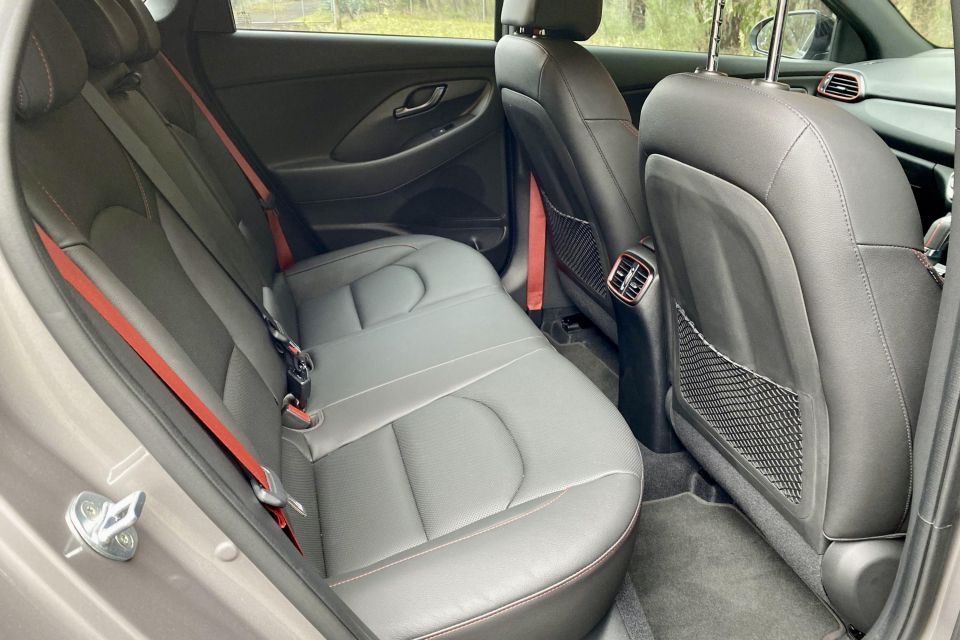
The back seats are quite spacious in terms of legroom, though that massive panoramic sunroof does eat into headroom. Still, it really does lift the ambience and has a solid retractable cover.
More importantly for this test, the back seats are more capacious than the Mazda’s, and the side windows are larger meaning you get more light and can see more outside. If practicality is a key purchase point, the Hyundai does it better.
The same story applies to the boot, which is wide and deep and comes with a cargo net, bag hook and 12V socket. The boot handles 395L – expanding to 1300L with the back seats folded.
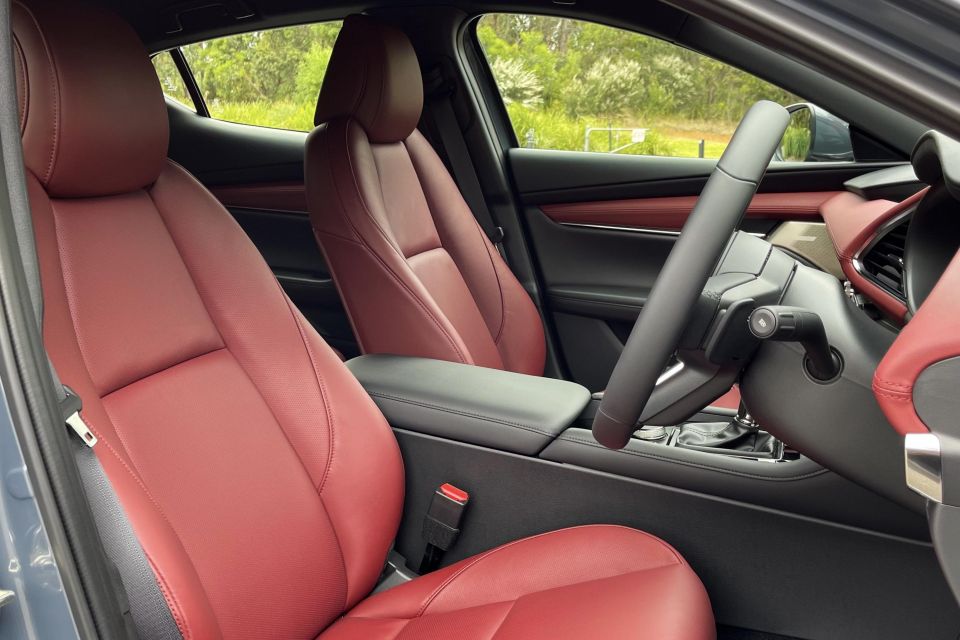

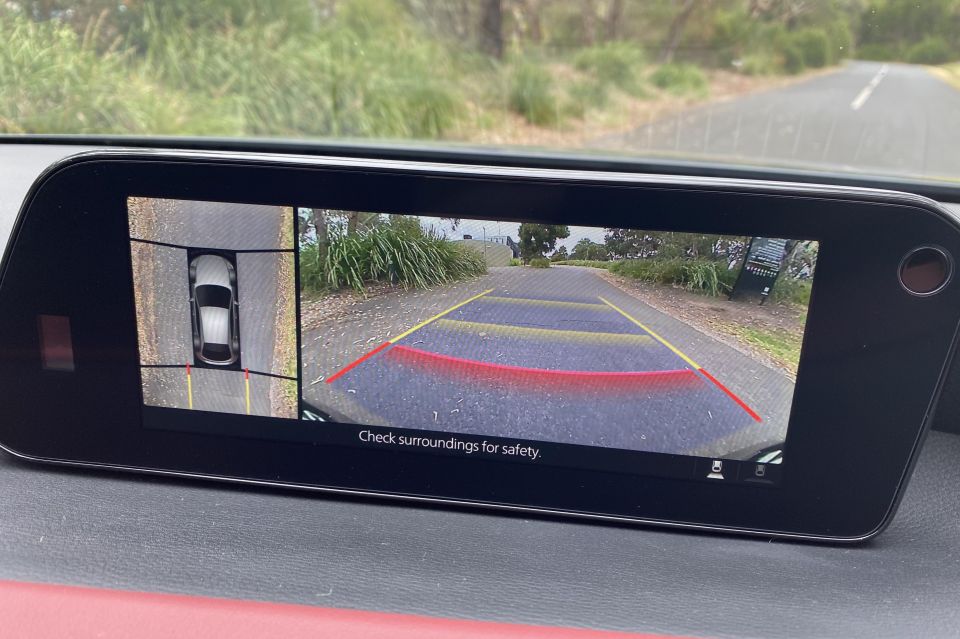
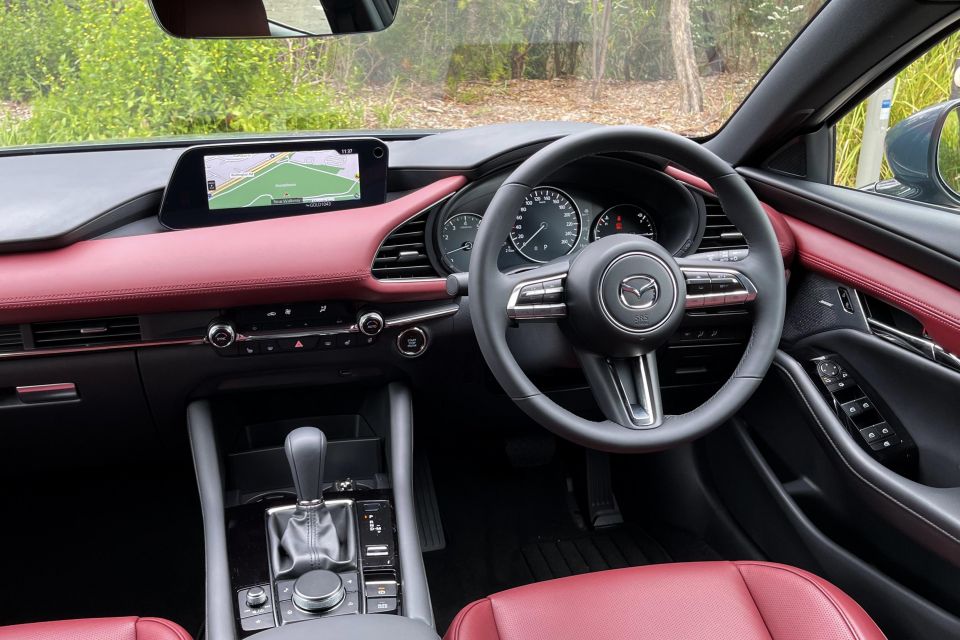
Mazda:
First impressions count, and on this metric the Mazda has the Hyundai’s measure.
The optional red leather (black is available too) covers not just the soft seats, but the dash and door touchpoints. The damped switches, knurled dials, and smaller details like the silver speakers, are truly Audi-lite. Mazda has put great effort into this and it shows.
You sit low, with your legs stretched out like in a sporty coupe. The wraparound vents, beautiful wheel, and projecting head-up display, mean you’re always comfortable, and truly ensconced in the car, and never on it. Those seats are softer and comfier too.
While the sunroof is smaller than the Hyundai’s, and the seats lack ventilation, the Mazda still impressed me more – certainly below surface level.
The driver instruments are more analogue than the Hyundai’s – though the virtual centre dial has three menu designs – and the HUD is your digitised speedo.
The centre screen is smaller diagonally, and cannot be used as a touchscreen at all. Instead you must use the rotary dial between the seats – older-design current Audis such as the Q2 are the same – which is augmented by shortcut buttons.
It’s a good system for keeping your eyes upwards, though never really integrates that well with touch-friendly Apple CarPlay. However, the system’s graphics and speed are miles ahead of older MZD Connect-installed Mazda products.
Special shout out must go to the Bose sound system, too, which might be the best this side of Lexus’s Mark Levinson units. The great NVH suppression only amplifies – sorry about that pun – the experience for Audiophiles.
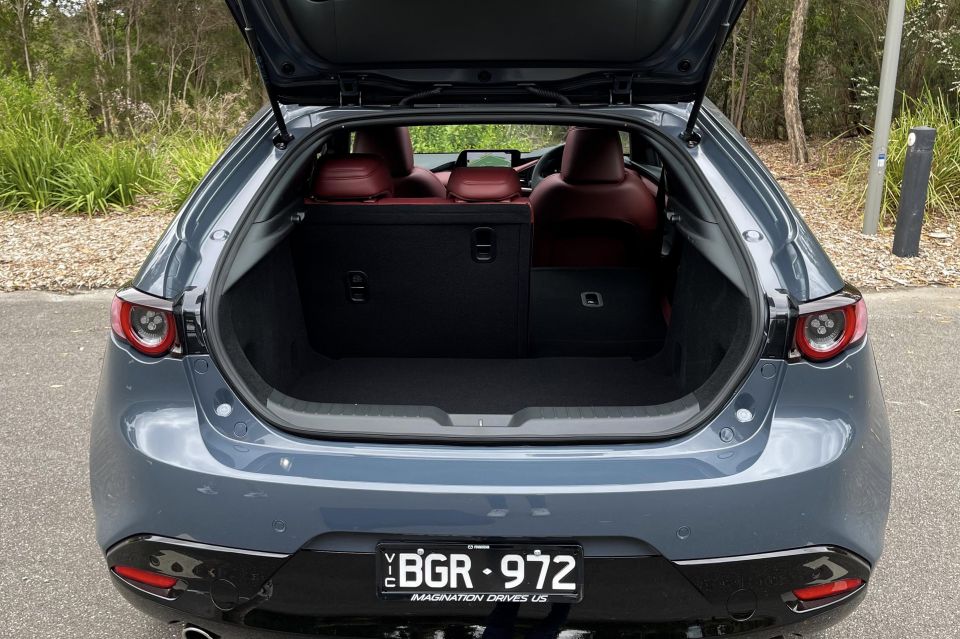
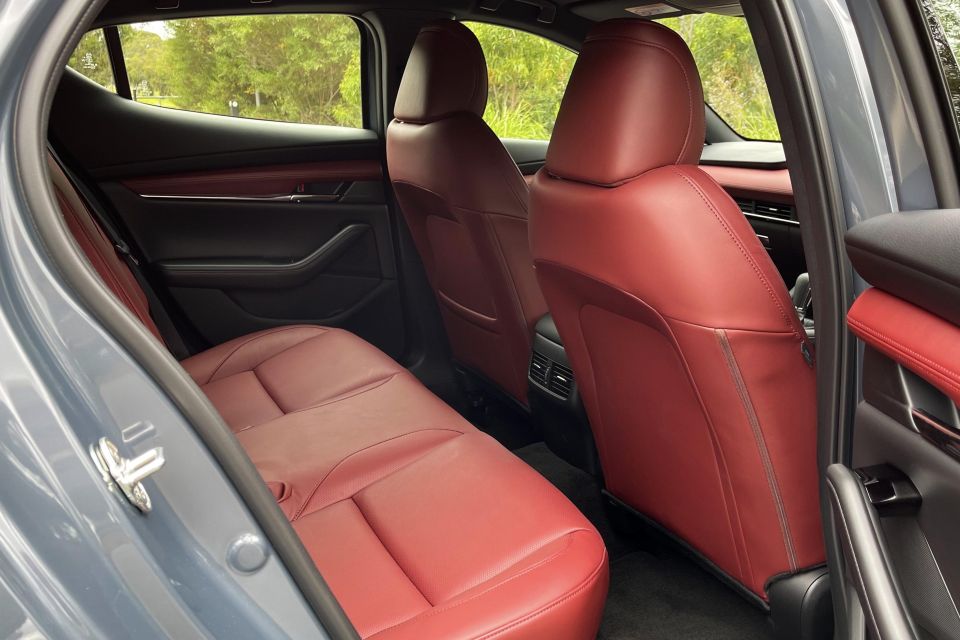
If you regularly carry four or five people in your small hatch, then best to look elsewhere. There’s not a terrible amount of headroom and legroom for any 180cm or below, but the small windows and big C-pillar do hem you in a bit.
That’s despite the Mazda’s longer wheelbase.
The Mazda’s boot is also 100L smaller than the Hyundai’s, and less clever in terms of nets and hooks. We do note that the 3 sedan has a bigger back seat and more cargo space.
| Hyundai | Mazda | |
|---|---|---|
| Length | 4395mm | 4460mm |
| Width | 1795mm | 1795mm |
| Height | 1453mm | 1435mm |
| Wheelbase | 2650mm | 2725mm |
| Boot space | 395L | 295L |
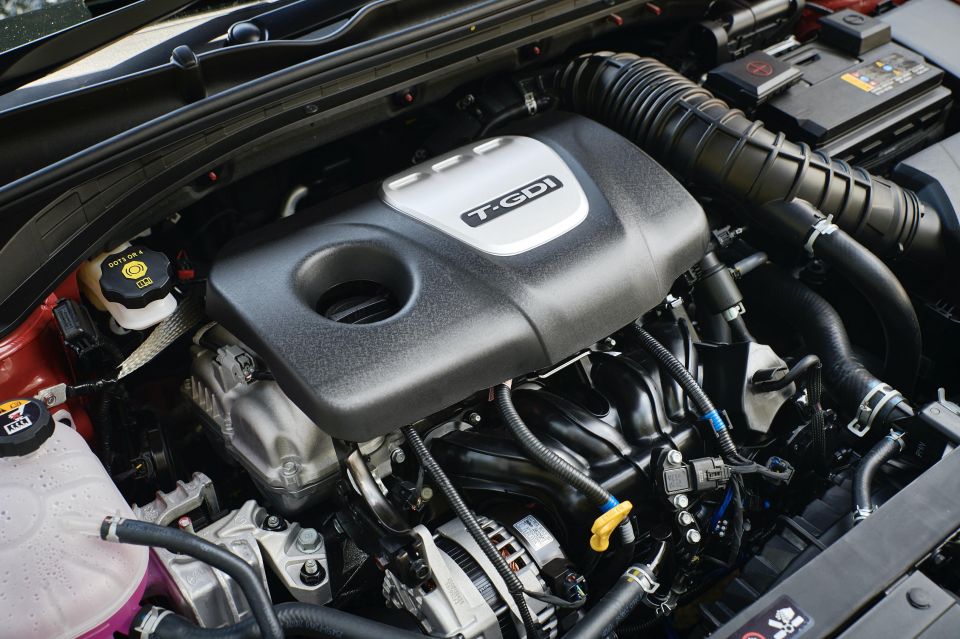
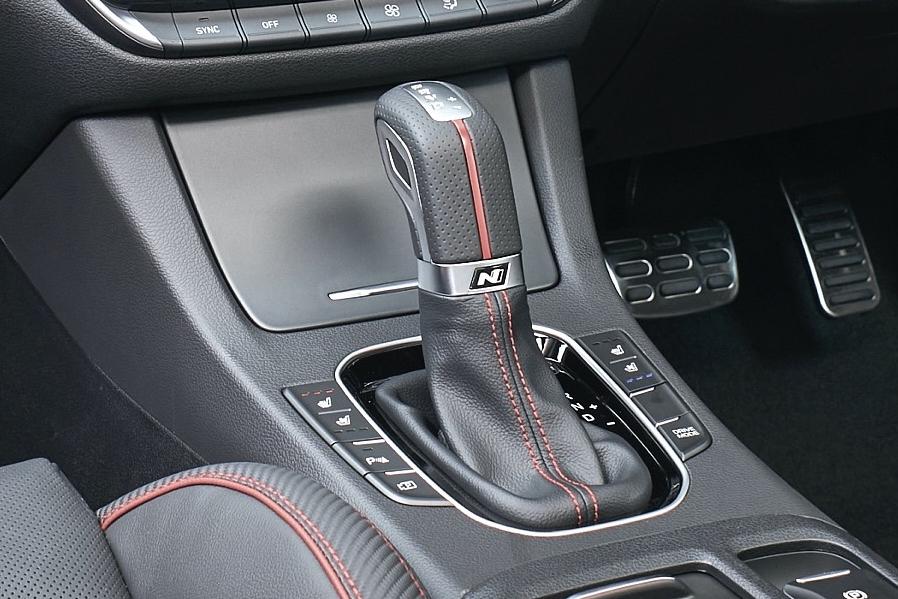
Hyundai:
A 1.6-litre turbocharged and direct-injected petrol engine producing 150kW of power at 6000rpm and 265Nm of torque between 1500 and 4500rpm.
Those outputs are sent to the front wheels via a seven-speed dry clutch DCT with paddles, or a six-speed manual for traditionalists.
In terms of fuel consumption, it’s designed to run on 91 RON and Hyundai claims consumption on a mixed loop of 7.1 litres per 100km.
Yet I managed impressive fuel economy of 6.7L/100km over a 600km driving loop comprising about 70 per cent country roads, some of which were dispatched swiftly.


Mazda:
The Mazda uses a 2.5-litre petrol engine with old-school natural aspiration, and produces 139kW at 6000rpm and 252Nm at 4000rpm. Notice how much later that torque becomes available…
Those outputs are sent to the front wheels via a six-speed torque-converter transmission with paddles and a rocker switch that tells it to downshift more aggressively under braking, or a six-speed manual for traditionalists.
In terms of fuel consumption, it’s designed to run on 91 RON and Mazda claims consumption on a mixed loop of 6.6 litres per 100km. It has nifty cylinder deactivation tech to save fuel, as well as idle stop/start.
However, while its ADR claim is lower, I averaged 7.8L/100km. There’s also the ‘X20’ Sky-Activ-X spark-guided compression ignition engine (check out our video on that here) available for an extra impost, but I don’t reckon the clever tech justifies its price.
| Hyundai | Mazda | |
|---|---|---|
| Fuel type | 91 RON | 91 RON |
| Fuel economy ADR | 7.1L/100km | 6.6L/100km |
| Displacement | 1.6-litre | 2.5-litre |
| Cylinders | Four | Four |
| Induction | Turbocharged | Naturally aspirated |
| Power | 150kW @ 6000rpm | 139kW @ 6000rpm |
| Torque | 265Nm @ 1500rpm | 252Nm @ 4000rpm |
| Power-to-weight | 109.1kW/tonne | 103.7kW/tonne |
| Transmission | 6MT or 7DCT | 6MT or 6AT |
| Driven wheels | Front | Front |
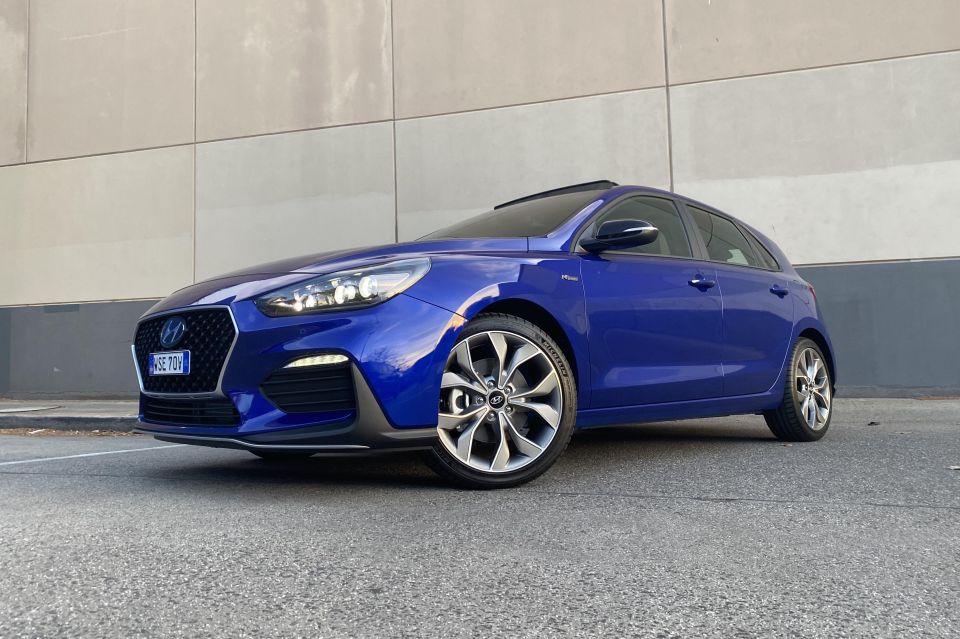
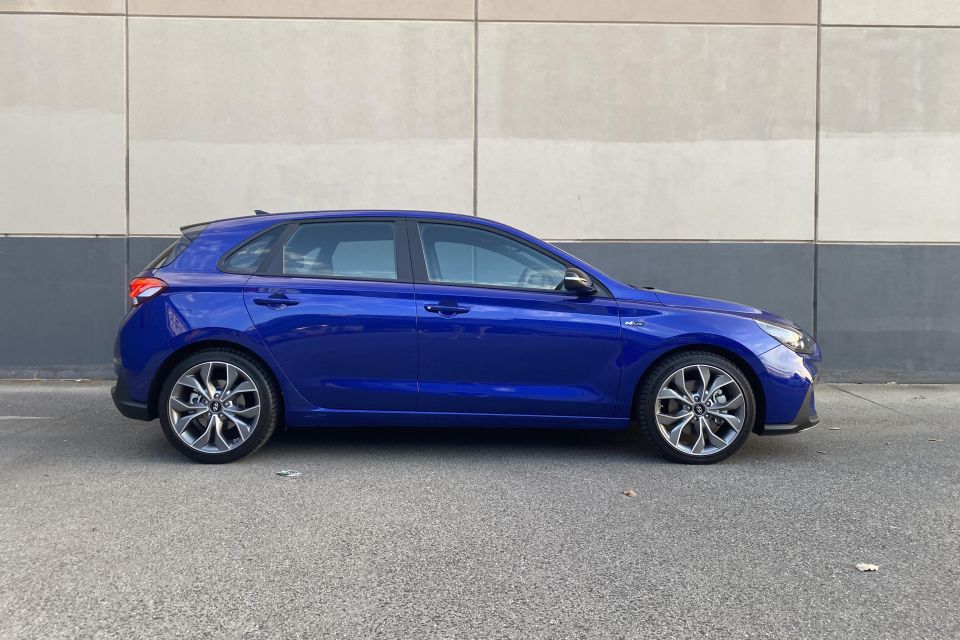
Hyundai:
The engine doesn’t have a particularly engaging soundtrack, but it does offer a nice slab of pulling power just above idle, which hangs about to offer a broad mid-range torque band that gives you good rolling response too.
The gearbox shifts quickly on the move, while the auto hold function reduces quirks such as rolling backwards in D before pressing the accelerator.
While not performing like a full-blooded hot hatch – it has neither the shove-in-the-chest punch or crackly soundtrack of the i30 N – it’s a pretty quick little warm hatch.
The three driving modes don’t make appreciable differences to the throttle mapping above modest application by design, though the sports mode does seem to tell the DCT to hold lower gears for a little longer.
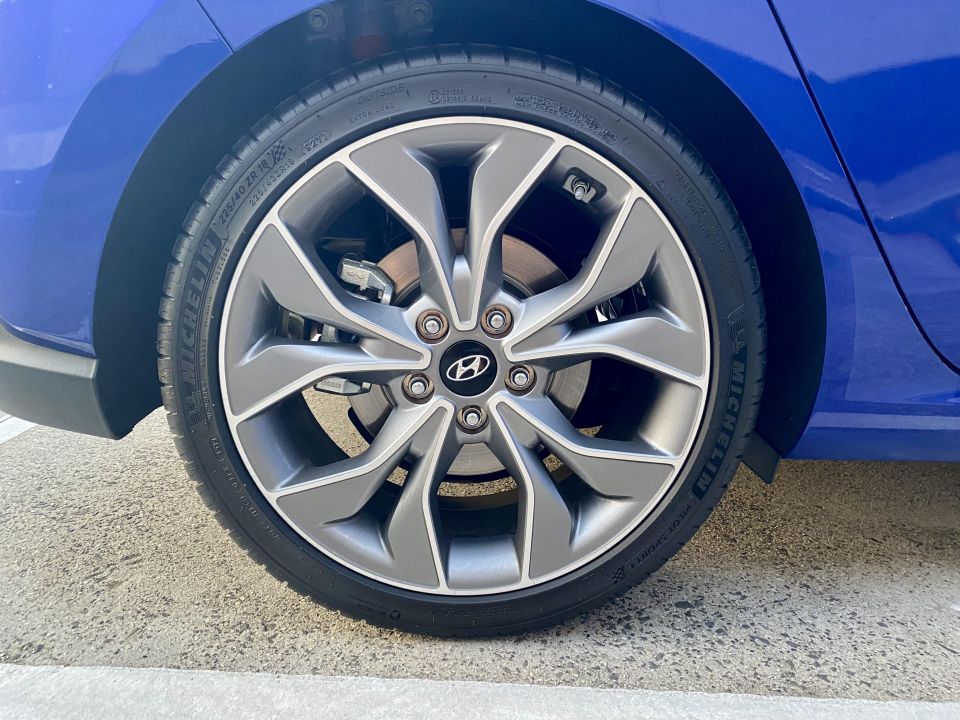
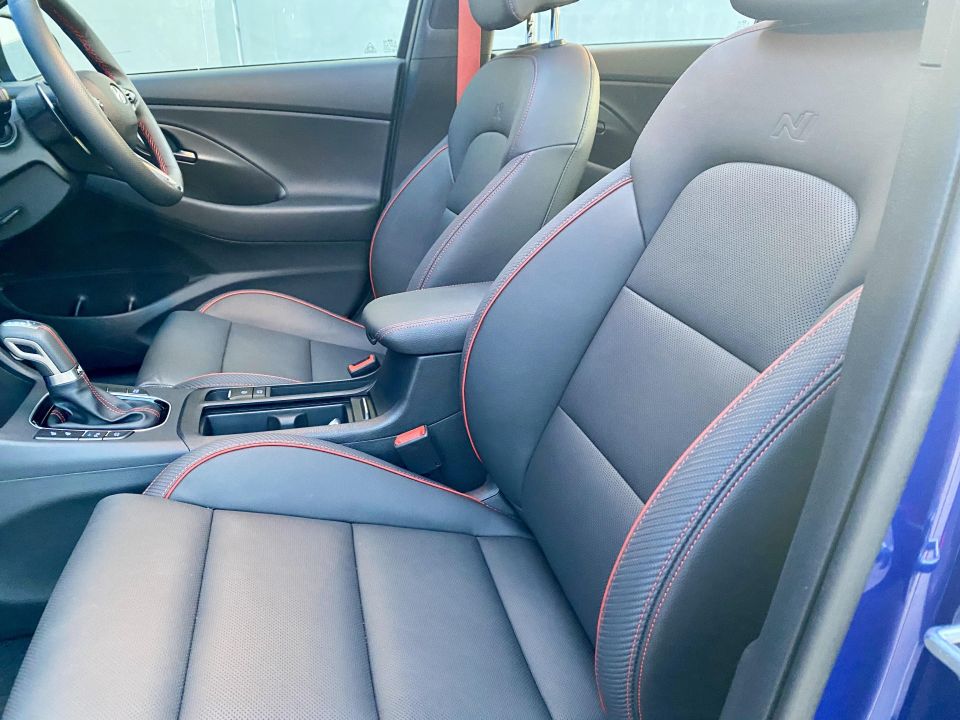
One real positive attribute of the i30 N Line models is the Aussie-developed suspension calibration, with springs, shocks, bushes, anti-roll bars and the like all specifically chosen for this market based on local testing.
Hyundai has done a great job retaining some ride comfort over harsh hits while tightening up the body control against cornering loads compared to base models, and maximising the swiftness of directional changes.
I found the electric motor-driven steering resistance a little much, but that’s just my taste.
To prove its performance bonafides, the N Line grades have larger front ventilated brake discs than cheaper i30s (305mm x 25mm), and pick up a multi-link rear suspension system to bolster road-holding over the base grades’ torsion or twist beam.
The main dynamic grievance comes from the tyres. The Michelin pilot Sport 4s are premium rubber and offer ample grip, especially off the mark where wheel spin is tamed, however there’s too much droning road noise at speed over coarser chip surfaces.
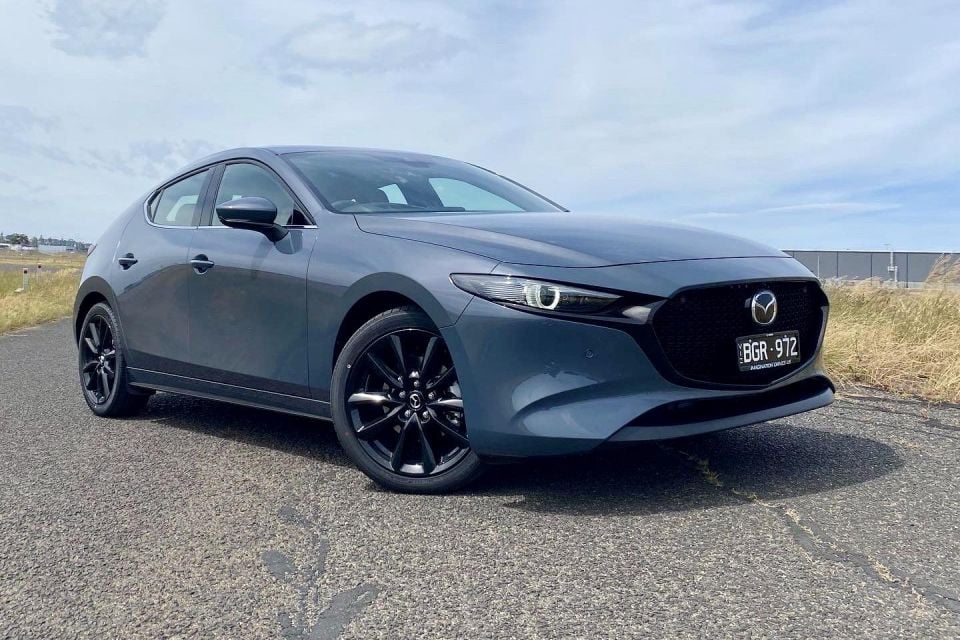
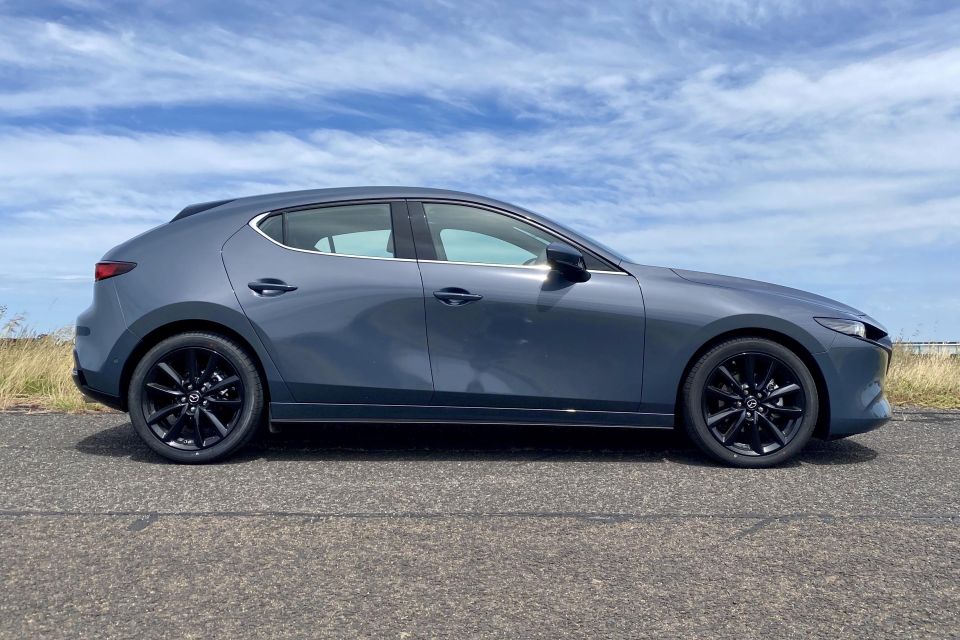
Where expert car reviews meet expert car buying – CarExpert gives you trusted advice, personalised service and real savings on your next new car.
Mazda:
The Mazda’s engine feels more old school, demanding revs to really give you its muscle.
But there’s definitely some poke there, and it has character and a distinctive soundtrack. It’s also very loud on cold starts as it rapidly gets itself to the ideal operating temperature.
The six-speed torque-converter auto looks similarly dated on paper, but Mazda has spaced the ratios nicely and it rarely feels outmatched. Previous experience also tells me the manual is a real cracker.
You have fewer driving modes to play around with than the Hyundai, but there’s a transmission sports mode as mentioned and stop/start, plus that nifty cylinder-on-demand tech.
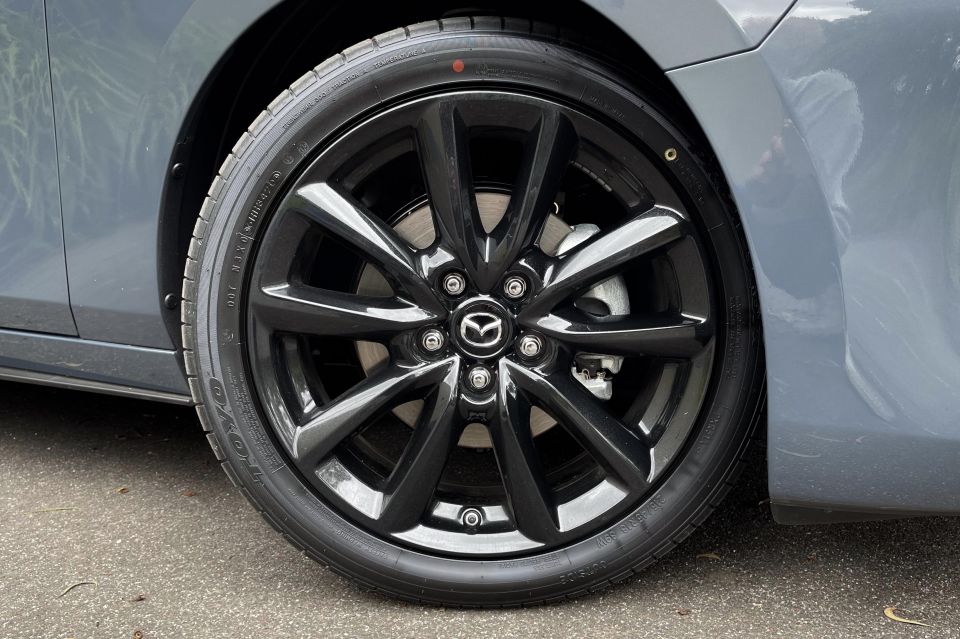
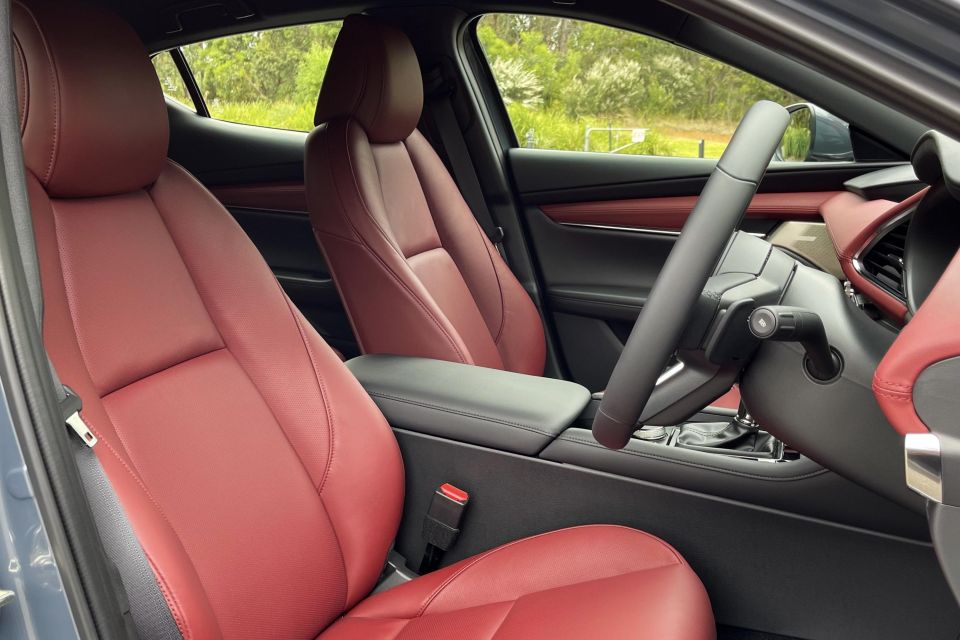
In terms of suspension, it’s a simpler setup with rear torsion beam suspension that – on paper – has less ability to keep the tyre surface on the road. Yet, during anything this side of a track day, I don’t think you’ll notice.
It has a less planted road feel than the well-tuned Hyundai, because it amplifies low-speed road bumps by promoting some body movement. However, it rounds-off impacts really well and is as agile and nippy in corners as the previous model.
The company’s proprietary G-Vectoring system cuts engine power delivery automatically and transfers the car’s weight, to tighten your lines. It’s subtle, but having done back-to-back slaloms in pre- and post- G-Vectoring-fitted cars, it makes a subtle difference.
There’s still a bit of rack-bumping through corners if you hit a bad surface, but it’s much better than older Mazdas.
The biggest improvement is refinement. The old Mazda 3 was often unbearably loud, but the new one has excellent sound insulation. At times, the interior noise at highway speeds was 4-5dB quieter than the Hyundai, according to my app.
| Hyundai | Mazda | |
|---|---|---|
| Kerb weight | 1436kg | 1380kg |
| Turning circle | 10.6m | 10.6m |
| Clearance | 135mm | 150mm |
| Front track | 1553mm | 1570mm |
| Rear track | 1562mm | 1580mm |
| Front suspension | MacPherson strut | MacPherson strut |
| Rear suspension | Multi-link | Torsion beam |
| Front brakes | Ventilated disc 305mm | Ventilated disc 295mm |
| Rear brakes | Solid disc 284mm | Solid disc 265mm |
| Tyres | Michelin Pilot Sport 4 | Toyo Proxes R51A |
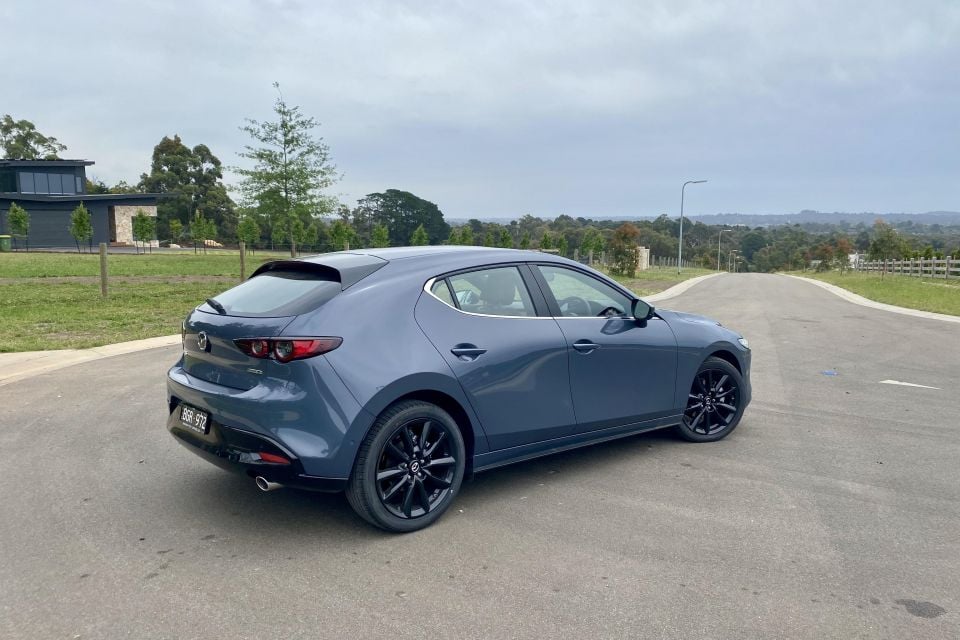
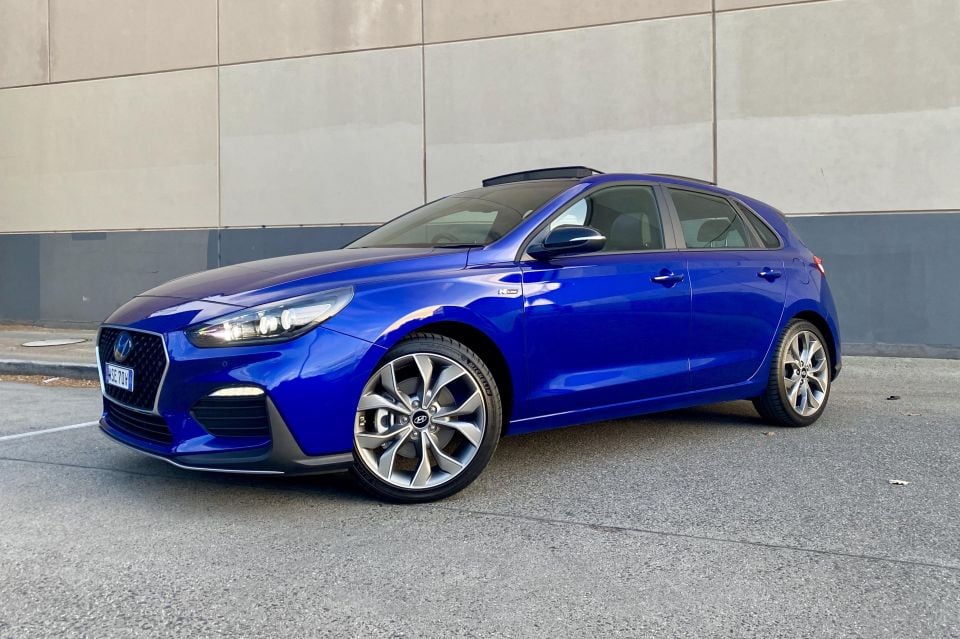
Hyundai and Mazda both provide a five-year, unlimited mileage warranty.
Service intervals for turbocharged Hyundai i30 models are annual or 10,000km, and the first five visits are capped at $299 apiece. You can shell out $1495 upfront to cover the first five visits.
Service intervals for the Mazda are likewise 10,000km or annual, which is too short given many competitors offer 15,000km intervals.
The first five visits cost $320, $366, $320, $366 and $320 ($1692 all up) – plus $100 for new cabin air filters every 40,000km, $71 for new brake fluid every two years, and $84 for a new engine air filter every three years.
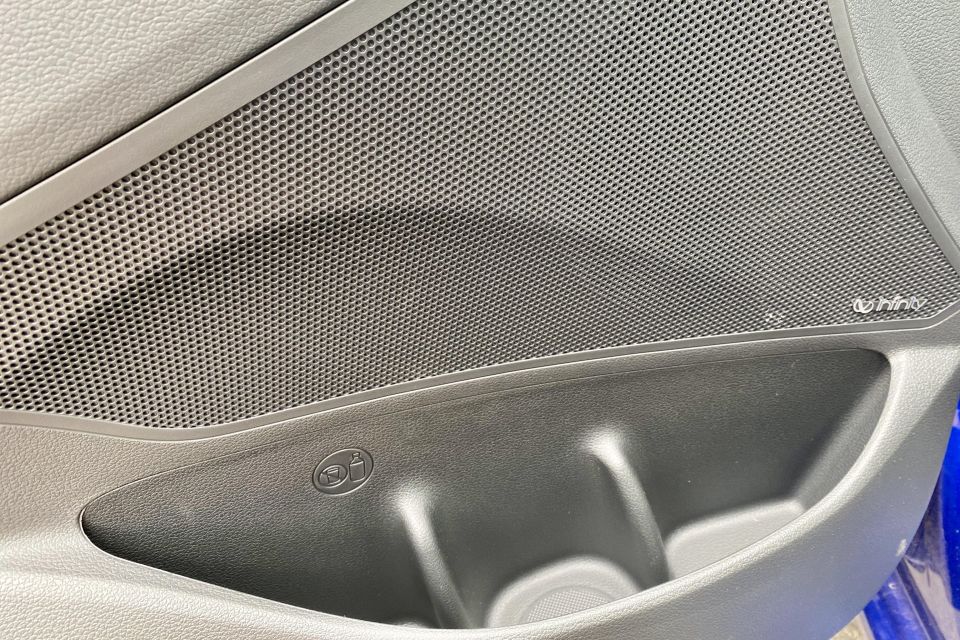

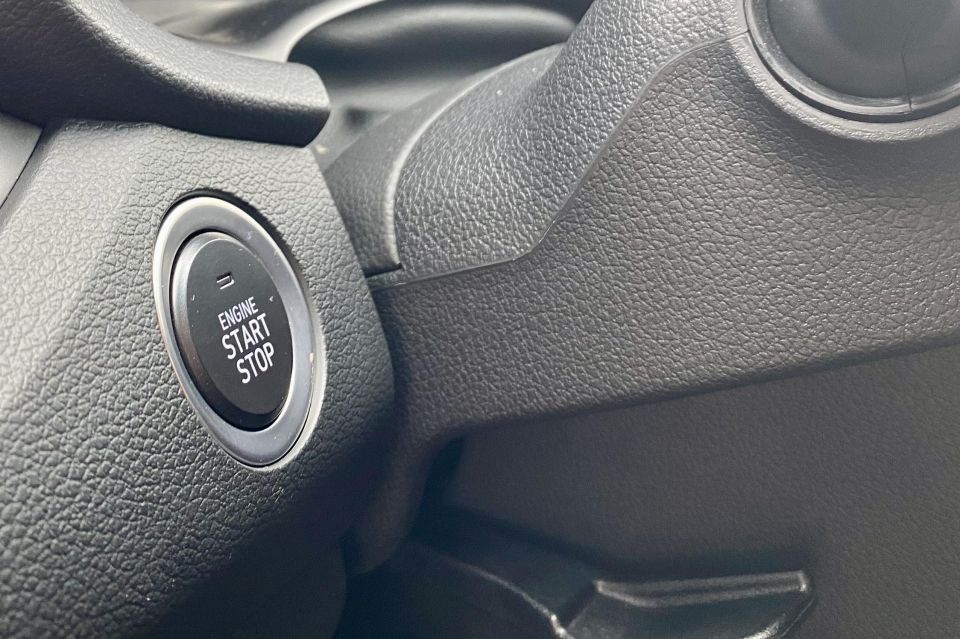

The Hyundai i30’s engine feels more muscular down low in the rev band, and it’s narrowly quicker off the mark. This is thanks to its turbocharger and dual-clutch transmission.
Those who value performance would do well to note the Aussie-specific damper and spring calibration, fitment of grippy tyres, and the more sophisticated independent rear suspension. However, beware the surplus of road noise that enters the cabin at times.
There’s a solid argument to make that the Hyundai also has better infotainment – the screen is certainly bigger, and being touch-sensitive it works better with phone mirroring – and it’s definitely the more practical of this pair.
Also, what other $40,000 car gives you a panoramic sunroof and ventilated seats, ey?
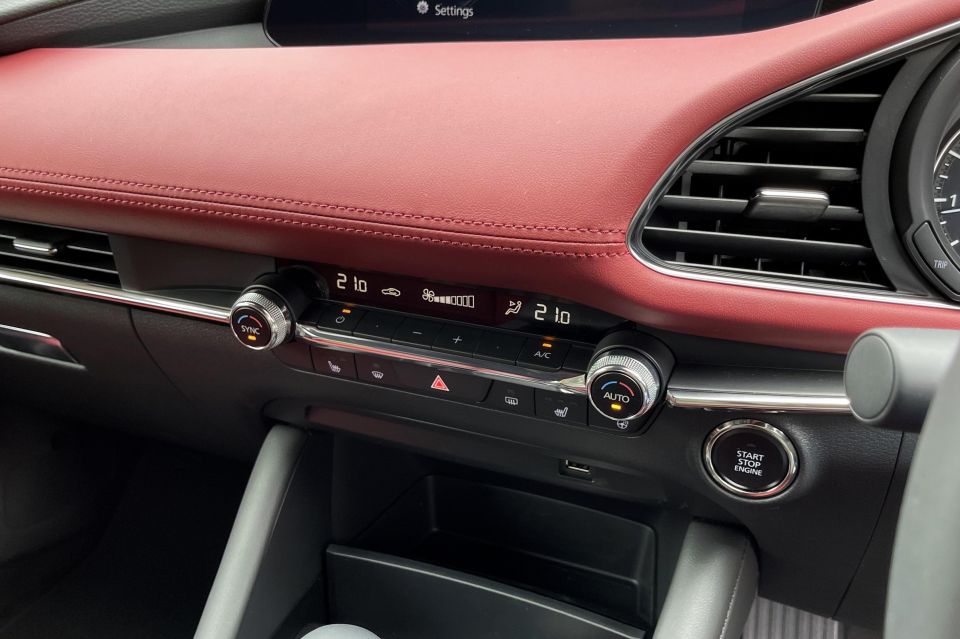
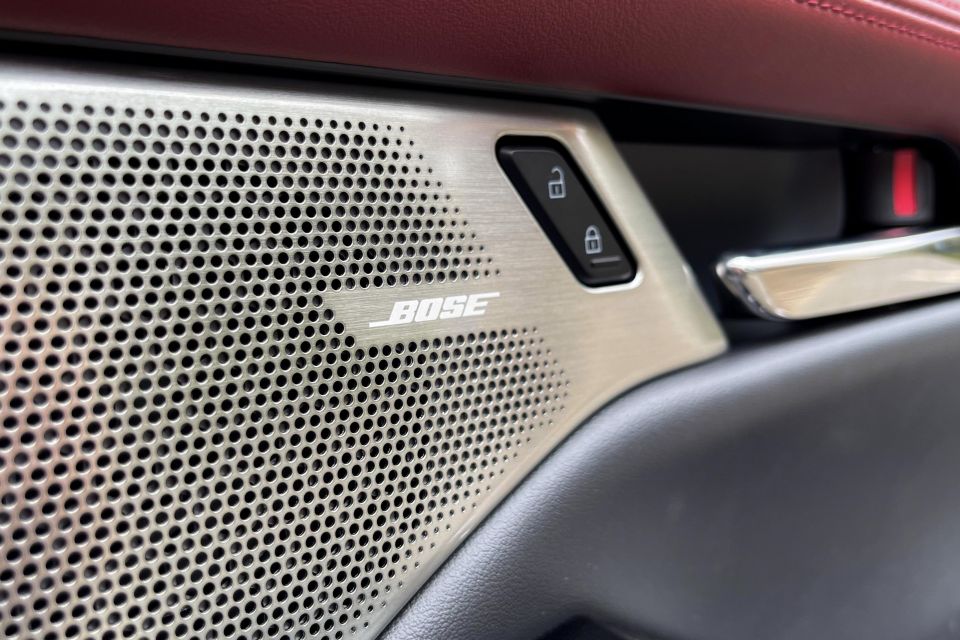
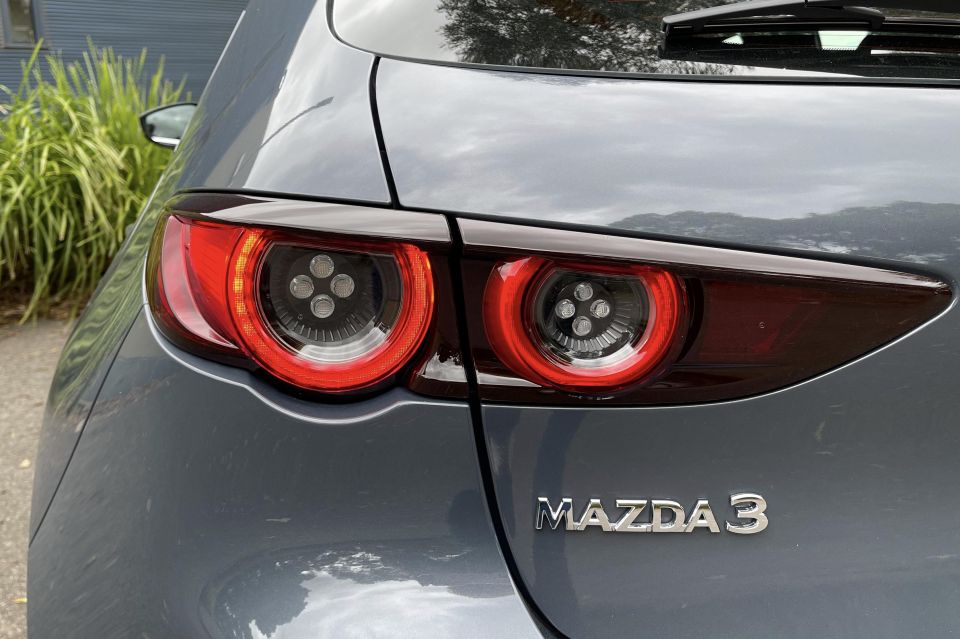
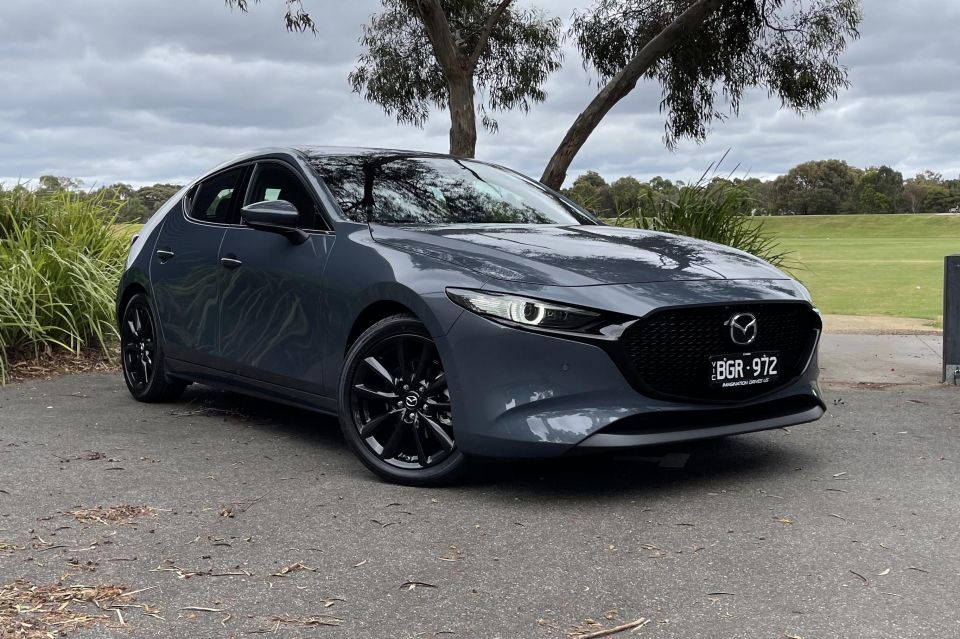
On the other hand, the Mazda 3’s aspirated engine and torque-converter auto are smoother around town and in my opinion more characterful, because you’re encouraged to rev it out a little more.
While the chassis allows commendable agility, and the steering is nicely weighted and controlled by a delightfully thin-rimmed wheel, it’s the excellent noise suppression and comfortable ride character that really impressed me more.
The interior is less capacious, and it’s harder to see out of. But the material quality is on a whole different level, and the attention to detail is just excellent. There’s a head-up display and superior 360-degree parking camera, too, and more active safety tech.
There’s also the purely subjective issue of design. To my eyes, the Mazda 3 hatch is gorgeous whereas the i30 is plain. Ironically, the Mazda 3 sedan is plain whereas the new i30 sedan looks aggressive and edgy as all get-out.
If I’m in your shoes, reader, I’m driving away in the Mazda. Be aware of each car’s pros and cons, and you won’t go wrong.
MORE: Hyundai i30 news and reviews MORE: Mazda 3 news and reviews
Share your thoughts with us in the comments below!
Share your thoughts and write a review of a car you own and get featured on CarExpert.


Ben Zachariah
14 Hours Ago


Damion Smy
15 Hours Ago
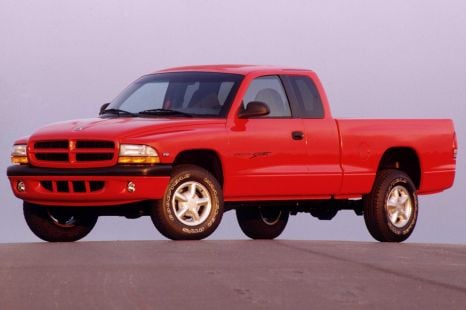

Derek Fung
15 Hours Ago


Ben Zachariah
16 Hours Ago
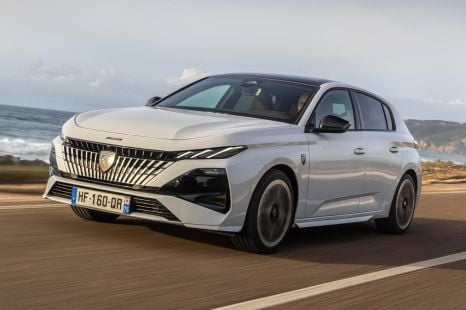

Matt Robinson
22 Hours Ago
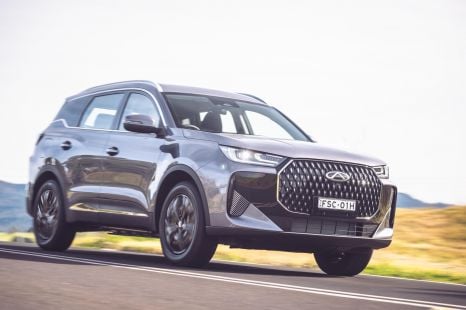

CarExpert.com.au
1 Day Ago